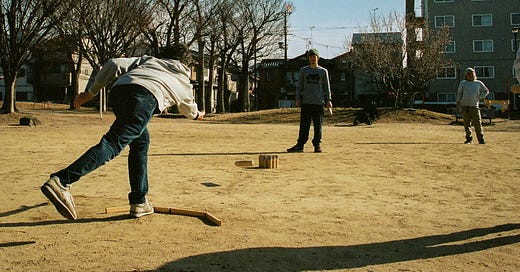I didn’t know if I wanted to exercise today because I felt terribly tired. But I packed my training shoes anyway.
I keep forgetting to drink my vitamins, so I bought a second bottle and set it on my office desk.
Overcast weather makes for boring, flat images. But I loaded my camera with film anyway.
On this day, I put no pressure on myself to work out, take vitamins, or capture photos. But instead of deciding prematurely that these activities wouldn’t work out, I increased my chances of doing them from 0 to… 10%? 20%? just by preparing for it. The worst case scenario is that the situations are not ideal and I don’t do them (I skip the gym, I forget to take my vitamins, I’m uninspired so the lens cap never leaves my camera). But by not ruling these activities out, there’s a chance of the best-case scenario: I work out, take vitamins, capture a good photo.
My approach for doing an activity contrasts with the absolute, hyper-optimized, efficient systems that productivity junkies may follow when trying to manufacture habits into their lives. A fixed 5AM alarm. A 30-day running streak. A Sunday that has no slack for sleeping in. Instead of setting a rigid schedule and a fool-proof setup, I focus instead on tweaks that would increase my chances of doing The Thing That I Want To Do.
The next habit I’m trying to (re)build is painting whenever I have 15 minutes to spare. I revived my crusty gouache kit by spritzing it with water to reactivate the paints and packed the palette into my backpack alongside a waterbrush and a small 3x5 sketchbook.
I may not paint every time I’m free, but at least now I have a non-zero chance of doing it.
Thank you to folks who help give publishing essays a non-zero chance: , , , , and .
Looking back: To understand the changes in stock trading, consider the process of buying equities a few decades ago. Say you heard your friends talking about a promising public company that was selling for $50 a share. You would’ve had to call your stockbroker and customarily would’ve aske±d to buy a round lot of 100 shares for $5,000. To put together a reasonably diversified portfolio of 20 companies that way, you’d need $100,000. — Source: Bloomberg
Update log:
📖 Reading The Millionaire Fastlane by MJ DeMarco (26% completed). Not a fan of his extremely bro-ey voice but curiosity is keeping me going. Note to self: more women should write about finance.
🎮 Finished Phoenix Wright Ace Attorney and started the second one in the series, Justice for All. These games are remastered for the Nintendo Switch, which is what I’m playing the trilogy series on.
📷 Learning about overexposing shots on film. I’m trying one roll out and I’ll try to shoot 36 exposures to see the result.
👟 Bought a new pair of sneakers for Hyrox. For some instances, I’m very picky when buying new things because it takes up space, but I needed a pair of shoes that can accommodate running, dynamic moves like burpees, and are stable for heavy weights.
🩺 Did a breast ultrasound as part of my routine checkup. The doctors found a lump last year which after some ultrasounds and FNAC procedures turned out to be benign, but I’ve been recommended to go check every four months just in case. If any of you are curious what this experience is like, I’m happy to write about it.
🍄🟫 Adding king oyster mushroom to my minced meat dishes (chop them into tiny dices roughly the same size) has increased the flavour of my dishes tremendously.
Some links are affiliate links, meaning that I may receive a commission if you make a purchase through the links at no cost to you.






🥹 painting when you have time to spare!!!!! You are reawakening the paints! 💎🎨
The original Ace Attorney trilogy is one of my favorite game series ever. I'm replaying the first one now =)